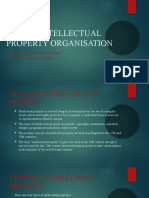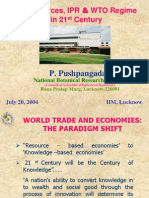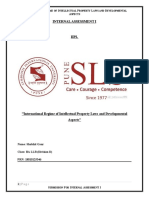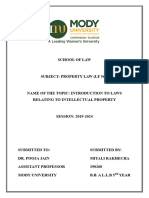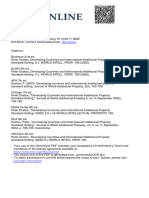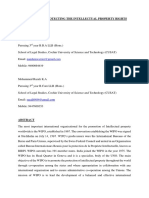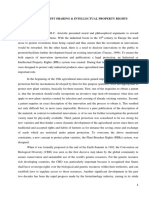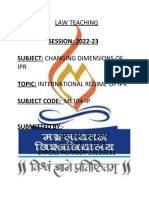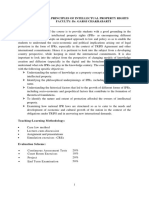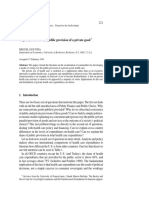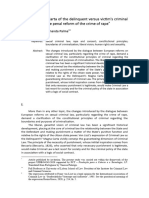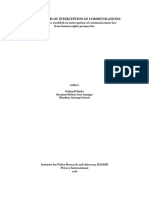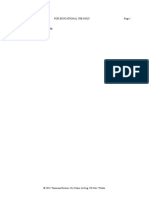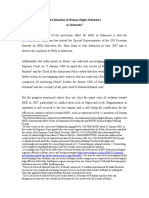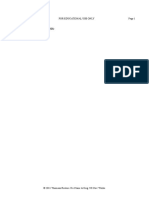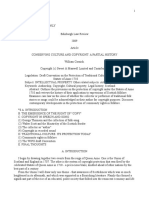Professional Documents
Culture Documents
Weerawit Weeraworawit FOLKLORE N Terjemahan
Uploaded by
JokoWidodoOriginal Title
Copyright
Available Formats
Share this document
Did you find this document useful?
Is this content inappropriate?
Report this DocumentCopyright:
Available Formats
Weerawit Weeraworawit FOLKLORE N Terjemahan
Uploaded by
JokoWidodoCopyright:
Available Formats
11 CDZJICL 769 FOR EDUCATIONAL USE ONLY Page 1
11 Cardozo J. Int'l & Comp. L. 769
(Cite as: 11 Cardozo J. Int'l & Comp. L. 769)
© 2011 Thomson Reuters. No Claim to Orig. US Gov. Works.
11 CDZJICL 769 FOR EDUCATIONAL USE ONLY Page 2
11 Cardozo J. Int'l & Comp. L. 769
(Cite as: 11 Cardozo J. Int'l & Comp. L. 769)
Cardozo Journal of International and Comparative Law
Summer 2003
Symposium
Traditional Knowledge, Intellectual Property, and Indigenous Culture
Articles
*769 FORMULATING AN INTERNATIONAL LEGAL PROTECTION FOR GENETIC RESOURCES,
TRADITIONAL KNOWLEDGE AND FOLKLORE: CHALLENGES FOR THE INTELLECTUAL
PROPERTY
SYSTEM
Weerawit Weeraworawit [FNa1]
Copyright © 2003 Yeshiva University; Weerawit Weeraworawit
Introduction
Since 1883, the Paris Convention for the Protection of Industrial Property, and since 1886, the Berne
Convention for the Protection of Literary and Artistic Works, including their respective revisions and related
agreements, have established the international protection of innovation and creativity with the clearly defined
sets of rules and standards. Those rules and standards have been adopted and reinforced by the Agreement on
the Trade Related Aspects of Intellectual Property Rights (TRIPS) of the World Trade Organization (WTO).
However, these organizations have been increasingly perceived as non-responsive to the growing demand that
innovation and creativity, in the forms of traditional knowledge and folklore, as well as genetic resources,
should be accorded international legal protection. Many assert that the present intellectual property system has
not been geared to protect the likes of traditional knowledge, folklore, and genetic resources. Some argue that
there are several elements of intellectual property, both in terms of concept and mechanisms, which could and
should be applied to give sufficient legal protection to these issues. Some contend that there is a need to create a
sui generis system for them. In any case, traditional knowledge and folklore, and have become emerging global
issues that are here to stay and will not go away. The run-up to and the outcome of the Fourth Session of the
WTO Ministerial Meeting in Doha last November clearly shows that the importance and value of these new
global issues has been recognized in the context of international trade. The wording is broad enough to satisfy
both the member countries that are keen *770 supporters of the setting up of international legal protection for
these issues and those countries that are yet to be converted. The Ministerial Declaration adopted at the WTO
Ministerial Conference made a special reference [FN1] to the work to be undertaken by the TRIPS Council
concerning the relation between the TRIPS Agreement and the CBD, in particular the protection of traditional
knowledge. The latest development in the WTO is not an isolated incident. There have been efforts at the
domestic, regional, and international levels to deal with these global and emerging issues. The rate of progress
greatly varies, ranging from the making of international agreements such as the Convention on Biological
Diversity (CBD) under the UN, and the International Treaty on Plant Genetic Resources for Food and
Agriculture under the FAO, to a series of consultations.
The World Intellectual Property Organization (WIPO) has carried out a series of studies and consultations
among the member states on the global and emerging intellectual property issues, notably in terms of traditional
knowledge, folklore, genetic and biological resources, and biodiversity. [FN2] The new global issues were
incorporated in the agenda activities of WIPO with the endorsement of the General Assembly in 1999.
© 2011 Thomson Reuters. No Claim to Orig. US Gov. Works.
11 CDZJICL 769 FOR EDUCATIONAL USE ONLY Page 3
11 Cardozo J. Int'l & Comp. L. 769
(Cite as: 11 Cardozo J. Int'l & Comp. L. 769)
It is clear that the so-called global and emerging issues involve the works and concerns of other
international and regional organizations regarding the legal means of protection, access and transfer of
technology, scientific and technical cooperation in the preservation and sustainable use of biodiversity, and
benefit sharing. It is also clear that intellectual property has an indispensable role in the formulation of an
internationally acceptable regime on the global and emerging issues. [FN3]
Intellectual property has to be studied in relation to other international agreements and instruments,
especially the Convention on Biological Diversity, Decision 391 of the Commission of the *771 Cartagena
Agreement, the International Undertaking on Plant Genetic Resources of the Commission on Genetic Resources
for Food and Agriculture, UPOV, the TRIPS Agreement. It goes without saying that there is a need for the
WIPO, UNEP, FAO, UNESCO, and the WTO to work together closely.
At the present time, there is no comprehensive regime governing the protection and exploitation of the
global and evolving issues mentioned above. However, there have been unequivocal developments underlying
the fact that the issues of traditional knowledge, folklore, genetic resources, and biodiversity are being tackled
seriously in the international context. (These are not just a flash in the pan or merely the futile aspirations of
developing countries.) The outcome of the WIPO Meeting on Intellectual Property and Genetic Resources,
Geneva, April 17-18, 2000 clearly shows broad international consensus that the issue of genetic resources is not
a North-South issue, and recognition of the inter-relationship and inter-dependence among the issue of genetic
resources with the new global issues of folklore, traditional knowledge, and biodiversity. The Meeting reached
the consensus that WIPO should facilitate the continuation of consultations among Member States in
coordination with the other concerned international organizations, through the conduct of appropriate legal and
technical studies, and through the setting up of an appropriate forum within WIPO for future work. This led to
the setting up of the Intergovernmental Committee on Intellectual Property and Genetic Resources, Traditional
Knowledge and Folklore, which has convened two meetings already on April 30-May 3, 2001 and December
10-14, 2001 in Geneva. If things follow their normal course in the WIPO context, it is expected that the
Intergovernmental Committee could follow the footsteps of other WIPO intergovernmental committees in
reaching enough international consensus to pave the way for the convening of a diplomatic conference and the
making of an international agreement or a set of agreements on these issues.
In order to determine the desirable international regime for the new global issues, it is crucial to look at the
rationale for giving international legal protection, the present protection afforded by the existing international
agreements and arrangements, present problems, and likely solutions.
*772 Rationale
From the intellectual property perspective and evolution, the two international agreements, the 1883 Paris
Convention on industrial property and the 1886 Berne Convention on copyright, have served to give protection
to innovative and creative works respectively. Patents afford protection to something new without giving regard
to the sources of research and development giving rise to such new invention. This emphasis on protection of
novelty, while ignoring the sources, has become more pronounced with the progress of biotechnological
innovations making use of genetic resources and gives rise to complaints by developing countries about
'biopiracy.' In the case of copyright, expressions of folklore do not benefit from the copyright regime due to the
simple fact that copyright gives a limited period of protection to new expressions, thus excluding most
expressions of folklore handed down from generation to generation, or even practiced in many societies as a
way of life. Of course, the Berne Convention in Article 19 [FN4] allows members to give protection greater than
that resulting from the Convention itself, but such protection is only effective domestically, not internationally.
Some argue that lack of novelty and limited periods of protection do not automatically result in no legal
© 2011 Thomson Reuters. No Claim to Orig. US Gov. Works.
11 CDZJICL 769 FOR EDUCATIONAL USE ONLY Page 4
11 Cardozo J. Int'l & Comp. L. 769
(Cite as: 11 Cardozo J. Int'l & Comp. L. 769)
protection for works of traditional knowledge, including indigenous designs, and various expressions of folklore
since some intellectual property rights such as trade secret or undisclosed information, trademarks especially
certification marks, copyright and its related rights, geographical indications, and patent itself as well as the
competition law could be used to afford adequate legal protection. [FN5] They suggest that the word 'tradition'
should not mean 'old' but 'the manner of producing such knowledge, and not to the date on which the knowledge
was produced.' Thus, traditional knowledge is knowledge that has been developed based on the traditions of a
certain community or nation. Following such definition, traditional knowledge and folklore would not be barred
on the ground of lack of novelty. However, there have been no *773 internationally uniform definitions of the
terms 'traditional knowledge' and 'folklore'.
The rationale for giving international legal protection to genetic resources, folklore, and traditional
knowledge is the departure from the individual-focused rights in the mainstream international agreements on
intellectual property, as it emphasizes the communal rights. It is the community that benefits from the
protection, not any single individual, since it is the community that keeps traditional knowledge, folklore, and
genetic resources alive. Critics argue that it is impossible to identify the source of genetic resources, folklore, or
traditional knowledge. This argument could be easily defeated by pointing out the ongoing works by
international organizations such as UNESCO in collecting data on expressions of folklore in the global context
and the efforts of various countries in preserving their national heritage. These efforts have been highly
facilitated by the advance in information technology. The same goes for genetic resources. As for genetic
resources, the Convention on Biological Diversity (CBD) has given a big push to the importance of the
conservation of biodiversity, as it states that the conservation of biodiversity is a common concern of mankind
and that States have sovereign rights over the biological resources in their territories. Article 1 defines the
objectives of the CBD as "the conservation of biological diversity, the sustainable use of its components and the
fair and equitable sharing of the benefits arising from the use of genetic resources, including by appropriate
access to genetic resources and by appropriate transfer of relevant technologies, taking into account all rights
over those resources and to technologies, and by appropriate funding." The stage has been set for a new kind of
rights, whose co-existence of with the long-established concept of patent is uneasy at the moment. [FN6]
It could also be argued that even the traditional rationale for the protection of intellectual property rights
could be used in support of the legal protection of the global and emerging issues. The concept of reasonable
reward for the inventor or creator could be applied to genetic resources, traditional knowledge, and folklore. The
people or communities that have a role in the preservation and maintenance of such materials have the right to
reasonable reward, *774 at least on par with the inventor or creator who enjoys protection in the form of
industrial property and copyright, as well as other new rights as stipulated in the TRIPS Agreement. The
granting of benefits seems to be more readily accepted in the field of genetic resources used in agriculture as
shown in the International Treaty on Plant Genetic Resources for Food and Agriculture as adopted by the 31st
Session of the Conference of the FAO on Nov.3, 2001, which clearly acknowledges Farmers' Rights. [FN7]
Traditional Knowledge, Genetic Resources, and Folklore
Traditional knowledge, genetic resources, and folklore are intertwined. The very concept of traditional
knowledge is clearly stipulated in Article 8(j) of the CBD in connection to conservation of biological diversity in
the sense that the Contracting Parties:
shall, as far as possible and as appropriate...subject to their national legislation, respect, preserve and
maintain knowledge, innovations and practices of indigenous and local communities embodying traditional
lifestyles relevant for the conservation and sustainable use of biological diversity and promote their wider
application with the approval and involvement of the holders of such knowledge, innovations and practices
and encourage *775 the equitable sharing of the benefits arising from the utilization of such knowledge,
© 2011 Thomson Reuters. No Claim to Orig. US Gov. Works.
11 CDZJICL 769 FOR EDUCATIONAL USE ONLY Page 5
11 Cardozo J. Int'l & Comp. L. 769
(Cite as: 11 Cardozo J. Int'l & Comp. L. 769)
innovations and practices. [FN8]
It could be seen that the provision is not mandatory due to the terms "as far as possible and as appropriate"
which give member states a high degree of leeway. However, it has given rise to some regional arrangements,
notably, those of the Andean Pact comprising Bolivia, Colombia, Ecuador, Peru and Venezuela. [FN9] It should
be mentioned here that Thailand, though not a member of the CBD, has passed the Protection of Plant Varieties
Act 1999, providing legal protection to not only new plant varieties along the line of UPOV, but also indigenous
plant varieties with clearly defined provisions on the rights of the local community concerned, including
authorization, access, and benefit sharing. The effect of this law was very much debated during its passage in the
Thai Parliament as to whether it would favour multinational companies which have accumulated new plant
varieties, some of which are believed to be developed by indigenous plants, or the local plant breeders who have
been consistently prolific. At the end, a balance was struck with the dual approach of giving protection to both
new and indigenous plant varieties.
The Andean Pact Common System on Access requires applicants seeking access to obtain the prior
informed consent of, and share benefits with, both the Competent National Authority and indigenous, Afro-
American, and local communities. Non-compliance with the access regulations gives rise to possible
cancellation of any intellectual property right conferred. This is the most formal arrangement on the recording of
contributions to inventions. There is a less formal arrangement such as that of Southern Africa, involving shared
information, research and conservation planning, *776 and the development of regional policies and statements
that reflect unique local conditions.
On the identification of source, there seems to be consensus across the board that it is desirable, but no
consensus on the uniform practice in the case of non-compliance. The European Union has Recital 27 of
Directive 98/44/EC, which stipulates that "Whereas if an invention is based on biological material of plant or
animal origin or if it uses such material, the patent application should, where appropriate, include information on
the geographical origin of such material, if known; whereas this is without prejudice to the processing of patent
applications or the validity of rights arising from granted patents." It should be noted that the factor of
knowledge plays an important role. This factor puts an onus on the countries owning traditional knowledge and
genetic resources to have clear information on what they have alone and in common. The industrial sector,
containing biotechnological innovations in the developed countries, often raises the problem of identifying the
accurate source of materials they use. This problem is not difficult to overcome because comprehensive
databases could be provided in the near future. It should be further noted that in the case of the European Union
the non-disclosure of source does not give rise to any erosion of the granted rights.
The TRIPS Agreement is silent on traditional knowledge, genetic resources, folklore and biodiversity.
However, it has certain provisions that could be interpreted in favour of the concept of transfer of technology
and access. Article 7 stipulates the objectives of the Agreement that "The protection and enforcement of
intellectual property rights should contribute to the promotion of technological innovation and to the transfer
and dissemination of technology, to the mutual advantage of producers and users of technological knowledge
and in a manner conducive to social and economic welfare, and to a balance of rights and obligations." Article 8
stipulates the principles that include the prevention against the abuse of intellectual property rights or restrictive
practices. These provisions are broad and subjected to the interpretation by the Member states. They provide the
safeguard, but not the protection for traditional knowledge, genetic resources, or folklore directly. The same
thing could be said about Article 27.2 on the exclusion from patentability on the ground of public order or
morality, including prejudice to the environment. They could be used to prevent against unfair or abusive
exploitation of genetic resources, *777 but they do not confer legal protection to traditional knowledge or
© 2011 Thomson Reuters. No Claim to Orig. US Gov. Works.
11 CDZJICL 769 FOR EDUCATIONAL USE ONLY Page 6
11 Cardozo J. Int'l & Comp. L. 769
(Cite as: 11 Cardozo J. Int'l & Comp. L. 769)
genetic resources. Article 67 deals with technical cooperation from the developed countries to the developing
and least developed countries. It also refers to assistance in the prevention against abuse. So the TRIPS
provisions are either remedial or preventive in nature as they do not confer rights upon traditional knowledge or
genetic resources.
In any case, the issue of access will not simply go away because the lack of international uniform practice.
Another development in the FAO, through the revision of the International Undertaking on Plant Genetic
Resources under the Commission on Genetic Resources for Food and Agriculture, which is a non-binding
agreement, reaffirms the crucial importance of access in its Article 11 dealing with access to plant genetic
resources for food and agriculture. The Article stipulates that "Parties recognize the sovereign rights of States
over their plant genetic resources for food and agriculture, including the authority to determine access to those
resources with the national governments and is subject to national legislation, and in the exercise of sovereign
rights, Parties shall facilitate access without imposing restrictions that run counter to the Convention on
Biological Diversity and this Undertaking." In addition, the International Undertaking also aims to set up a
multilateral system of access and benefit sharing. It also emphasizes farmer's rights in Article 15.1, which states
that "the Parties recognize the enormous contribution that farmers of all regions of the world, particularly those
in the centres of origin and crop diversity, have made and will continue to make for the conservation and
development of plant genetic resources which constitute the basis of food and agriculture production throughout
the world." Article 15.2 spells out the farmers' rights, including the protection of traditional knowledge and the
right to equitably participate in benefit-sharing. However, as indicated earlier, the FAO has gone one step further
by adopting on, November 3, 2001 a binding agreement, namely, the International Treaty on Plant Genetic
Resources for Food and Agriculture, which incorporates Farmers' Rights and the multiple system of access and
benefit sharing. This development has complemented the CBD in a way beneficial to those actually involved in
the use and maintenance of genetic resources. The International Treaty is open for signature by FAO or UN
members *778 from November 3, 2001 and November 4, 2002. [FN10] It will enter into force on the ninetieth
day after the deposit of the fortieth instrument of ratification, acceptance, approval or accession, provided that at
least twenty instruments of ratification, acceptance, approval or accession have been deposited by Members of
FAO. [FN11]
Although the concept of access is deemed desirable, it has not made much leeway into the established
patent regime, judging from the response to the questionnaire sent out by the Working Group on Biotechnology
to the WIPO member states. Out of the 50 countries that responded, only 5 countries gave a positive response to
the question: "does your legislation include any special provisions to ensure the recording of contributions to
inventions (such as the source of government funding, the source of generic resources that originate or are
employed in biotechnological inventions, the grant of prior informed consent to have access to those resources,
etc.)?" Thirty-five countries replied that they did not plan to introduce legislation to ensure the recording of such
contributions.
However, the WIPO Meeting on Genetic Resources of 17-18 April 2000 established a strong consensus for
the WIPO to set up an appropriate forum within the WIPO for the future work on genetic resources and related
issues. It also shows that many countries have not made up their mind on changing the patent regime to give
international legal protection to genetic resources, and traditional knowledge. In any case, it underlines the
importance of these new global issues which continue to generate debates and discussions far beyond the
confine of the patent regime.
Expressions of folklore are not protected by copyright. However, the new works derived from the
expressions of folklore enjoy copyright protection. The databases of expressions of folklore also enjoy
© 2011 Thomson Reuters. No Claim to Orig. US Gov. Works.
11 CDZJICL 769 FOR EDUCATIONAL USE ONLY Page 7
11 Cardozo J. Int'l & Comp. L. 769
(Cite as: 11 Cardozo J. Int'l & Comp. L. 769)
copyright protection as a compilation work in accordance with both the Berne Convention and the TRIPS
Agreement. [FN12]
The WIPO and UNESCO have carried out joint activities to determine the international legal protection for
expressions of folklore. One of the results of such collaboration is the 1982 Model Provisions for National
Laws on the Protection of Expressions of *779 Folklore against Illicit Exploitation and Other Prejudicial
Actions, popularly known as the Tunis model law on the protection of expressions of folklore. Due to the
overbroad nature of the availability and scope of protection, the model law was not widely adopted. The lull
was broken with the WIPO-UNESCO World Forum on the Protection of Folklore on April 8-10, 1997 in
Phuket, Thailand. The Forum in its Phuket Statement requested the WIPO and UNESCO to work together in
finding an appropriate protection for the expressions of folklore. As a result, four regional consultations were
organized in 1999. They all emphasized the importance of expressions of folklore and related issues in the
modern economy.
In the world of information technology, satellite broadcasting, and the Internet, expressions of folklore have
gained more economic value due to their very own creativity, preserved and refined by the indigenous or local
communities. The merchandising business associated with copyright works and expressions of folklore has
become more prominent. A clear example is the merchandises associated with the Sydney Olympics, 2000,
where products inspired by or based on the Aboriginal folklore and traditional knowledge had generated huge
income. The fast increasing popularity of the entertainment portion in the Internet means greater demand for
creative works. Expressions of folklore have become an obvious source of choice, as they are free of charge due
to the lack of international legal protection.
The need to seek international legal protection has been shaped by one historical development, namely
regional countries were influenced by the arts and culture of their neighboring countries. The common
expressions of folklore are common phenomena. So there is a need to catalogue the existing expressions of
folklore to facilitate identification and to acknowledge the fact that in several cases, regional countries have to
share benefits. The very exercise of cataloguing and identification will help preserve expressions of folklore that
are valuable national heritages, in the face of the onslaught brought about by Western value and lifestyle. The
process of seeking to share benefits from the common expressions of folklore will help to strengthen mutual
appreciation and respect, an important factor contributing to regional peace and stability.
Critics of the international legal protection of folklore often argue that expressions of folklore are already
in the public domain, any attempt to create a special protection would create confusion *780 and uncertainty as
well as undermine the very concept of copyright. It could be countered that protection of expressions of folklore
is not copyright protection. It should be noted that the European Union now gives special protection to non-
original or non-copyrighted data in the database if they have been collected with substantial financial investment
and if they constitute a substantial part of the database. Such practice is clearly a departure from the very
concept of copyright.
Solutions
At this point, it is clear beyond doubt that there is no unified international legal protection of folklore,
traditional knowledge, genetic resources, and biodiversity, although there is a general consensus that such new
global issues should be tackled together in a comprehensive manner, and in connection with intellectual property
to produce an internationally acceptable regime. The WIPO Intergovernmental Committee on Intellectual
Property and Genetic Resources, Traditional Knowledge and Folklore is doing this at the moment. Parallel
efforts have been launched by the Fourth Session of the WTO Ministerial Meeting last November, to the effect
© 2011 Thomson Reuters. No Claim to Orig. US Gov. Works.
11 CDZJICL 769 FOR EDUCATIONAL USE ONLY Page 8
11 Cardozo J. Int'l & Comp. L. 769
(Cite as: 11 Cardozo J. Int'l & Comp. L. 769)
that there will be serious consultation on the expansion of the scope of Article 23 of TRIPS, beyond wines and
spirits and into the realm of traditional knowledge and related issues as well as affording greater flexibility in
approaching patents on life-saving medicines.
There is no international consensus on the substance of the internationally acceptable regime of protection.
This is to be expected, as the countries having the resources in the form of genetic resources, traditional
knowledge, and folklore would try to secure protection for such resources, and the user countries would be
reluctant to subject themselves to any additional restraints to their producing of innovations and creativity in line
with the existing intellectual property agreements-this is a little bit unclear. However, such perceived resistance
may not be long-lasting once a clearer form and substance of the internationally acceptable regime emerges.
Besides, the user countries are at the same time the holders of genetic resources, traditional knowledge, and
folklore and vice versa. Australia [FN13] and Canada [FN14] are clear examples of the developed *781
countries that have dual interests, and give legal protection of their respective traditional knowledge and
folklore, including the products of indigenous culture through the existing intellectual property system.
Consequently, the new global issues are not the North-South issues, as both the developed and developing
countries share the desire to find an appropriate mechanism or arrangement to give adequate protection,
although they may not superficially seem so.
It would be extremely unrealistic to expect the international community to agree on the substance of the
protection of the new global issues overnight. To achieve international consensus on the form and substance of
such regime needs serious and continuous consultations among the members of the international community,
aided by elucidated studies by the WIPO and other international agencies concerned. The future is not as
pessimistic as many critics believe. The horizontal cooperation among the international organizations is
producing results, as can be seen from the harmony between the new International Treaty on Plant Genetic
Resources for Food and Agriculture and the CBD, which has greatly improved the farmers' rights at not only the
domestic level but also the international level.
*782 It is also crucial for the developing countries that are the owners of the resources, under the new
global issues, to be able to agree among themselves on the best possible model. This could start from the
collection and sharing of information on their respective resources (i.e. the making of electronic databases),
[FN15] ease and convenience of retrieval of information, identification of problems involved, exploration of
options without predetermined results, forging regional and international consensus, and having strong political
will to establish a fair, convenient, and practical multilateral system. [FN16] The WIPO Intergovernmental
Committee has made remarkable progress, as seen from the active participation of the member countries,
particularly those from Asia, [FN17] Africa, and Latin America.
*783 There is a greater need for educating and making the public understand the issues involved in order to
facilitate their maximum use of the present intellectual property system to legally protect, whenever possible,
their genetic resources, traditional knowledge, and folklore, while regional and international consultation on the
protection of these new global issues is going on. The better understanding will, on the one hand, help avoid
confrontation, and on the other hand, encourage continuous and balanced consultation and negotiation, as the
present intellectual property system is perceived as being bias toward the developed countries and multinational
companies. [FN18]
To sum up, there must continue to be a distinct forum, whatever its designation, for consultations among the
regional countries and on the global basis. The WIPO Intergovernmental Committee seems to be the appropriate
© 2011 Thomson Reuters. No Claim to Orig. US Gov. Works.
11 CDZJICL 769 FOR EDUCATIONAL USE ONLY Page 9
11 Cardozo J. Int'l & Comp. L. 769
(Cite as: 11 Cardozo J. Int'l & Comp. L. 769)
forum at the moment, due to its broad mandate and participation of both the governments and the various groups
concerned. It should enhance cooperation with other international and regional organizations to ensure a
comprehensive approach that is perceived as convenient, fair and equitable by all the parties concerned, and to
make the best use of the ongoing efforts to find the most appropriate mechanism to give adequate international
legal protection to the global and emerging issues of genetic resources, traditional knowledge, and folklore.
There will be many obstacles on the way, but they are to be expected as the new global issues are complex and
intertwined, and involve, not only intellectual property rights, but also other major concerns such as
environmental and human rights. Now is the time for a holistic approach for the possibly hotly contested issues,
as we move closer to the making of an international agreement (s).
22 February 2002
[FNa1]. Minister (Commercial Affairs), Ministry of Commerce of Thailand and Associate Judge of the Central
Intellectual Property and International Trade Court on the occasion of the Symposium on Traditional
Knowledge, Intellectual Property, and Indigenous Culture at the Benjamin N. Cardozo School of Law, New
York City on 21-22 February 2002.
[FN1]. See para 19 of the Doha Ministerial Declaration: 'We instruct the Council for TRIPS, in pursuing its
work programme including under the review of Article 27.3(b), the review of the implementation of the TRIPS
Agreement under Article 71.1 and the work foreseen pursuant to paragraph 12 of this Declaration, to examine,
inter alia, the relationship between the TRIPS Agreement and the Convention on Biological Diversity, the
protection of traditional knowledge and folklore..." .
[FN2]. See the WIPO International Bureau Document No. WIPO/IP/GR/00/2 entitled Intellectual Property and
Genetic Resources- An Overview.
[FN3]. See the Chairman's Conclusions of the WIPO Meeting on Intellectual Property and Genetic Resources,
Geneva, April17-18, 2000.
[FN4]. Article 19 of the Berne Convention: The provisions of this Convention shall not preclude the making of a
claim to the benefit of any greater protection which may be granted by legislation in a country of the Union."
Berne Convention, 1971. art. 19.
[FN5]. See WIPO document No. WIPO/GRTKF/IC/2/9 dated December 3, 2001 'Survey on Existing Forms of
Intellectual Property Protection for Traditional Knowledge - Preliminary Analysis and Conclusions' prepared by
the WIPO Secretariat.
[FN6]. Colombia tried to introduce into the Patent Law Treaty a requirement to identify the genetic or biological
resource in a request for patent, but the consensus is to tackle this issue under a separate agenda as it involves a
very important issue of access and benefit sharing, not just a procedural matter.
[FN7]. See the preamble of International Treaty on Plant Genetic Resources for Food and Agriculture, and
particularly Article 9 on Farmers' Rights: 9.1 The Contracting Parties recognize the enormous contribution that
the local and indigenous communities and farmers of all regions of the world, particularly those in the centres of
origin and crop diversity, have made and will continue to make for the conservation and development of plant
genetic resources which constitute the basis of food and agriculture production throughout the world.
9.2 The Contracting Parties agree that the responsibility for realizing Farmers' Rights, as they relate to plant
© 2011 Thomson Reuters. No Claim to Orig. US Gov. Works.
11 CDZJICL 769 FOR EDUCATIONAL USE ONLY Page 10
11 Cardozo J. Int'l & Comp. L. 769
(Cite as: 11 Cardozo J. Int'l & Comp. L. 769)
genetic resources for food and agriculture, rests with national governments. In accordance with their needs
and priorities, each Contracting Party should, as appropriate, and subject to its national legislation, take
measures to protect and promote Farmers' Rights, including:
(a) protection of traditional knowledge relevant to plant genetic resources for food and agriculture;
(b) the right to equitably participate in sharing benefits arising from the utilization of plant genetic resources
for food and agriculture; and
(c) the right to participate in making decisions, at the national level, on matters related to the conservation
and sustainable use of plant genetic resources for food and agriculture.
9.3 Nothing in this Article shall be interpreted to limit any rights that farmers have to save, use, exchange
and sell farm-saved seed/propagating material, subject to national law and as appropriate. '
[FN8]. Convention on Biological Diversity, Article 8(j), 1992.
[FN9]. The Commission of the Cartegena Accord, or "Andean pact" introduced in July 1996 a regional measure
on access and benefit-sharing through Decision 391 which set up the "Common System on Access to Genetic
Resources" . The objective of the System is to "regulate access to the genetic resources of the Member Countries
and their derivatives, in order to; (a) Create the conditions for fair and equitable sharing of the benefits accruing
from such access; (b) Establish a basis for the recognition and appreciation of genetic resources, their
derivatives and related intangible components, particularly where indigenous, afro-american and local
communities are involved; (c) Encourage the conservation of biological diversity and sustainable use of
biological resources containing genetic resources; (d) Promote the consolidation and development of scientific,
technological and technical capacities at local, national and subregional level; and (e) Strengthen the negotiating
capacity of the Member Countries."
[FN10]. See International Treaty on Plant Genetic Resources for Food and Agriculture, Art. 25, November,
2001.
[FN11]. See International Treaty on Plant Genetic Resources for Food and Agriculture, Art. 25, 28, November,
2001.
[FN12]. See Berne Convention, 1971, art. 2(5); TRIPS Agreement, art. 10(2).
[FN13]. See supra note 4 ('Australia has identified four cases which, in its view, demonstrate the ability of the
Australian intellectual property regime to protect traditional knowledge: Foster v Mountford (1976) 29 FLR
233, Milpurrurru v Indofurn Pty Ltd (1995) 30 IPR 209, Bulun Bulun & Milpurrurru v R & T Textiles Pty Ltd
(1998) 41 IPR 513and Bulun Bulun v Flash Screenprinters (discussed in (1989) EIPR Vol 2, pp. 346-355). From
these cases it results that protection under the Australian Copyright Act can be as valuable to Aboriginal and
Torres Strait Islander artists as it is to other artists. Furthermore, other intellectual property rights are available
for traditional knowledge protection, namely certification marks, the trademark system as a whole, and the
designs system.')
[FN14]. See id. para 9 ('In Canada, copyright protection under the Copyright Act has been widely used by
Aboriginal artists, composers and writers of tradition-based creations such as wood carvings of Pacific coast
artists, including masks and totem poles, the silver jewelry of Haida artists, songs and sound recordings of
Aboriginal artists and Inuit sculptures. Trademarks, including certification marks, are used by Aboriginal people
© 2011 Thomson Reuters. No Claim to Orig. US Gov. Works.
11 CDZJICL 769 FOR EDUCATIONAL USE ONLY Page 11
11 Cardozo J. Int'l & Comp. L. 769
(Cite as: 11 Cardozo J. Int'l & Comp. L. 769)
to identify a wide range of goods and services, ranging from traditional art and artwork to food products,
clothing, tourist services and enterprises run by First Nations. Many Aboriginal businesses and organizations
have registered trademarks relating to traditional symbols and names. In contrast, industrial designs protection
under the Industrial Design Act has not been widely used by Aboriginal persons or communities. The West
Baffin Eskimo Cooperative Ltd. filed over 50 designs in the late 1960s for fabrics using traditional images of
animals and Inuit people. It is becoming increasingly common for Aboriginal communities in Canada to sign
confidentiality agreements with governments and non-Aboriginal businesses when sharing their traditional
knowledge. For example, the Unaaq Fisheries, owned by the Inuit people of Northern Quebec and Baffin Island
is involved in fisheries management. The company regularly transfers proprietary technologies to other
communities using its own experience in the commercial fishing industry. The techniques it develops are
protected as trade secrets.'
[FN15]. The electronic databases could form the databases for the novelty search by the patent examiners.
Developing countries could negotiate with the major patent offices in the developed countries for the
compulsory search of such databases so as to prevent against biopiracy.
[FN16]. The multilateral system could be multi-tiered starting from the national authority and national fund to
manage traditional knowledge for the various communities, the regional authority and regional fund to manage
traditional knowledge at the regional level especially on the sharing of benefits for materials that exist in several
regional countries, and ultimately, the international authority and global fund to manage the benefit sharing of
countries from different parts of the world. The respective authorities could be run by committees of
representatives of the concerned parties. This multi-tiered system could be based on the compulsory licensing
basis, namely, payment of fixed rates for specific uses of certain materials without any need to seek approval
from the national, regional, or international authority concerned before hand. This compulsory licensing
approach has worked in Japan in the case of the use of sound recordings for commercial reproduction.
[FN17]. See WIPO document no. WIPO/GRTKF/IC/2/10 dated 3 December 2002 ('Position of the Asian Group
and China' which stipulates the following recommendations:"1.That WIPO is the most appropriate forum to
develop internationally acceptable and equitable solutions to the intellectual property issues related to genetic
resources, traditional knowledge and folklore and that the terms of reference of the WIPO Intergovernmental
Committee on Intellectual Property and Genetic Resources, Traditional Knowledge and Folklore should be as
broad as possible to enable policies, plans and mechanisms on the issues concerned to be fully developed; 2.
The Secretariat of the WIPO should ensure the full and well-informed participation of the developing countries
in the various meetings and consultation process in this regard; 3. The Intergovernmental Committee should
exchange views with a view to negotiating a comprehensive international instrument on the protection of genetic
resources, traditional knowledge and folklore; 4. In order to enhance the ability of developing countries to
strengthen their intellectual property systems particularly in dealing with the intellectual property issues related
to genetic resources, traditional knowledge and folklore, WIPO should offer increased capacity building to
developing and least-developed countries in the form of legal and technical assistance, training and the
provision of necessary equipment and other resources; 5.WIPO should undertake studies to find all possible
options, by which the success of the tasks relating to genetic resources, traditional knowledge and folklore could
be ensured; 6. Recognizing that the WIPO Arbitration and Mediation Center offers arbitration and mediation
services for the resolution of international commercial disputes between private parties, WIPO should study
possibilities of offering alternative dispute resolution services, including but not limited to arbitration and
mediation, which are particularly appropriate for the problems involving intellectual property issues related to
traditional knowledge and folklore;..."
© 2011 Thomson Reuters. No Claim to Orig. US Gov. Works.
11 CDZJICL 769 FOR EDUCATIONAL USE ONLY Page 12
11 Cardozo J. Int'l & Comp. L. 769
(Cite as: 11 Cardozo J. Int'l & Comp. L. 769)
[FN18]. The controversies concerning the exploitation of the Indian Neem tree and Basmati rice as well as Thai
Jasmine rice either through the patent or trademark system, are the clear examples of perceived bias of the
present intellectual property system in favour of the developed countries. However, if looked from the other
perspective, the persons perceived to have exploited the genetic resources and traditional knowledge are merely
making use of the present intellectual property system.
END OF DOCUMENT
Cardozo Jurnal Internasional dan Perbandingan Hukum
Musim panas 2003
Simposium
Pengetahuan Tradisional, Kekayaan Intelektual, dan Budaya Adat
Artikel
* 769 FORMULATIN G AN PERLINDUNGAN HUKUM INTERNASIONAL UNTUK SUMBER DAYA GENETIKA,
Folklore dan pengetahuan tradisional: TANTANGAN UNTUK KEKAYAAN INTELEKTUAL
SISTEM
Weerawit Weeraworawit [FNa1]
Copyright © 2003 Universitas Yeshiva; Weerawit Weeraworawit
Pengenalan
Sejak 1883, Konvensi Paris untuk Perlindungan Properti Industri, dan sejak 1886, Konvensi Berne untuk
Perlindungan Karya Sastra dan Seni, termasuk revisi masing-masing dan perjanjian terkait, telah menetapkan
perlindungan internasional inovasi dan kreativitas dengan jelas set aturan dan standar. Aturan-aturan dan
standar telah diadopsi dan diperkuat oleh Perjanjian tentang Trade Related Aspek Hak Kekayaan Intelektual
(TRIPS) dari Organisasi Perdagangan Dunia (WTO). Namun, organisasi ini telah semakin dianggap sebagai non-
responsif terhadap permintaan bahwa inovasi dan kreativitas, dalam bentuk folklore dan pengetahuan
tradisional, serta sumber daya genetik, harus diberikan perlindungan hukum internasional. Banyak yang
menyatakan bahwa sistem kepemilikan intelektual sekarang ini belum diarahkan untuk melindungi orang-orang
seperti pengetahuan tradisional, cerita rakyat, dan sumber daya genetik. Beberapa berpendapat bahwa ada
beberapa elemen kekayaan intelektual, baik dari segi konsep dan mekanisme, yang dapat dan harus diterapkan
untuk memberikan perlindungan hukum yang memadai untuk masalah ini.Beberapa berpendapat bahwa ada
kebutuhan untuk menciptakan sebuah sistem sui generis untuk mereka. Dalam kasus apapun, folklore dan
pengetahuan tradisional, dan telah menjadi isu global yang muncul yang di sini untuk tinggal dan tidak akan
pergi. Jangka-up dan hasil Sidang Keempat Pertemuan Tingkat Menteri WTO di Doha November lalu jelas
menunjukkan bahwa pentingnya dan nilai dari isu-isu global yang baru telah diakui dalam konteks perdagangan
internasional.Kata-kata ini cukup luas untuk memuaskan kedua negara anggota yang tertarik * 770 pendukung
pengaturan perlindungan hukum internasional untuk masalah ini dan negara-negara yang belum
dikonversi. Deklarasi Menteri yang diadopsi pada Konferensi Tingkat Menteri WTO membuat referensi khusus
[FN1] untuk pekerjaan yang akan dilakukan oleh Dewan TRIPS mengenai hubungan antara Perjanjian TRIPS
dan CBD, khususnya perlindungan pengetahuan tradisional.Perkembangan terbaru di WTO bukan insiden
terisolasi. Ada upaya-upaya di tingkat domestik, regional, dan internasional untuk menangani isu-isu global dan
muncul. Tingkat kemajuan sangat bervariasi, mulai dari pembuatan perjanjian internasional seperti Konvensi
Keanekaragaman Hayati (CBD) di bawah PBB, dan Perjanjian Internasional mengenai Sumber Daya Genetik
Tanaman untuk Pangan dan Pertanian di bawah FAO, dengan serangkaian konsultasi.
Properti Intelektual Dunia Organisasi (WIPO) telah melakukan serangkaian studi dan konsultasi antara negara-
negara anggota mengenai isu-isu global dan muncul kekayaan intelektual, terutama dalam hal pengetahuan
tradisional, cerita rakyat, sumber daya genetik dan biologis, dan keanekaragaman hayati.[FN2] Isu-isu global
yang baru dimasukkan dalam agenda kegiatan WIPO dengan dukungan dari Majelis Umum pada tahun 1999.
© 2011 Thomson Reuters. No Claim to Orig. US Gov. Works.
11 CDZJICL 769 FOR EDUCATIONAL USE ONLY Page 13
11 Cardozo J. Int'l & Comp. L. 769
(Cite as: 11 Cardozo J. Int'l & Comp. L. 769)
Hal ini jelas bahwa yang disebut isu-isu global dan muncul melibatkan karya-karya dan keprihatinan organisasi-
organisasi internasional dan regional lainnya mengenai cara-cara hukum perlindungan, akses dan alih teknologi,
kerjasama ilmiah dan teknis dalam pelestarian dan pemanfaatan berkelanjutan keanekaragaman hayati,
dan pembagian keuntungan. Hal ini juga jelas bahwa kekayaan intelektual memiliki peran yang sangat
diperlukan dalam perumusan rezim internasional diterima pada isu-isu global dan muncul. [FN3]
Kekayaan intelektual harus dipelajari dalam kaitannya dengan perjanjian internasional lainnya dan instrumen,
terutama Konvensi Keanekaragaman Hayati, Keputusan 391 Komisi Perjanjian 771 * Cartagena, yang
Melakukan Internasional tentang Sumber Daya Genetik Tanaman Komisi Sumber Daya Genetik untuk Pangan
dan Pertanian, UPOV, Perjanjian TRIPS.Tak perlu dikatakan bahwa ada kebutuhan untuk FAO WIPO, UNEP,
UNESCO, dan WTO untuk bekerja sama erat.
Pada saat ini, tidak ada rezim yang komprehensif yang mengatur perlindungan dan eksploitasi isu-isu global dan
berkembang yang disebutkan di atas. Namun, ada perkembangan yang mendasari tegas fakta bahwa masalah
pengetahuan tradisional, cerita rakyat, sumber daya genetik, dan keanekaragaman hayati sedang ditangani
serius dalam konteks internasional. (Ini bukan hanya flash dalam panci atau hanya sia-sia aspirasi negara-
negara berkembang.) Hasil Rapat WIPO pada Kekayaan Intelektual dan Sumber Genetika, Jenewa, April 17-18,
2000 jelas menunjukkan konsensus internasional yang luas bahwa masalah sumber daya genetik bukan
masalah Utara-Selatan, dan pengakuan hubungan inter-dan antar-ketergantungan antara masalah sumber daya
genetik dengan isu-isu global baru cerita rakyat, pengetahuan tradisional, dan keanekaragaman
hayati. Pertemuan itu mencapai konsensus bahwa WIPO harus memfasilitasi kelanjutan dari konsultasi antara
Negara Anggota dalam koordinasi dengan organisasi-organisasi internasional lainnya yang bersangkutan,
melalui pelaksanaan studi hukum dan teknis yang tepat, dan melalui pembentukan sebuah forum yang tepat
dalam WIPO untuk pekerjaan di masa depan. Hal ini menyebabkan pengaturan dari Komite Antar Pemerintah
mengenai Kepemilikan Intelektual dan Sumber Daya Genetik, Pengetahuan Tradisional dan Cerita Rakyat, yang
telah menyelenggarakan dua pertemuan sudah di 30 April - 3 Mei, 2001 dan 10-14 Desember 2001 di
Jenewa. Jika hal-hal normal mengikuti mereka dalam konteks WIPO, diharapkan bahwa Komite Antar
Pemerintah bisa mengikuti jejak komite WIPO lainnya antar pemerintah dalam mencapai konsensus
internasional cukup untuk membuka jalan bagi mengadakan konferensi diplomatik dan pembuatan perjanjian
internasionalatau satu set perjanjian pada masalah ini.
Dalam rangka untuk menentukan rezim internasional diinginkan untuk isu-isu global yang baru, sangat penting
untuk melihat alasan untuk memberikan perlindungan hukum internasional, perlindungan ini diberikan oleh
perjanjian internasional yang ada dan pengaturan, masalah ini, dan solusi mungkin.
* 772 Dasar Pemikiran
Dari perspektif hak kekayaan intelektual dan evolusi, dua perjanjian internasional, Konvensi Paris 1883 pada
properti industri dan Konvensi Berne 1886 tentang hak cipta, telah melayani untuk memberikan perlindungan
terhadap karya inovatif dan kreatif masing-masing. Paten memberikan perlindungan untuk sesuatu yang baru
tanpa memberikan memperhatikan sumber-sumber penelitian dan pengembangan sehingga menimbulkan
penemuan baru tersebut. Penekanan pada perlindungan baru, sementara mengabaikan sumber-sumber, telah
menjadi lebih jelas dengan kemajuan inovasi bioteknologi memanfaatkan sumber daya genetik dan menimbulkan
keluhan dari negara-negara berkembang tentang 'biopiracy. " Dalam kasus hak cipta, ekspresi dari cerita rakyat
tidak mendapatkan manfaat dari rezim hak cipta karena kenyataan sederhana bahwa hak cipta memberikan
jangka waktu terbatas perlindungan terhadap ekspresi baru, sehingga tidak termasuk ekspresi paling dari cerita
rakyat diwariskan dari generasi ke generasi, atau bahkan dipraktekkan di banyak masyarakat sebagai cara
hidup. Tentu saja, Konvensi Berne dalam Pasal 19 [FN4] memungkinkan anggota untuk memberikan
perlindungan lebih besar daripada yang dihasilkan dari Konvensi itu sendiri, tetapi perlindungan seperti ini hanya
efektif dalam negeri, bukan internasional. Beberapa berpendapat bahwa kurangnya hal baru dan periode
terbatas perlindungan tidak secara otomatis mengakibatkan tidak ada perlindungan hukum untuk karya
pengetahuan tradisional, termasuk desain asli, dan berbagai ekspresi dari cerita rakyat karena beberapa hak
© 2011 Thomson Reuters. No Claim to Orig. US Gov. Works.
11 CDZJICL 769 FOR EDUCATIONAL USE ONLY Page 14
11 Cardozo J. Int'l & Comp. L. 769
(Cite as: 11 Cardozo J. Int'l & Comp. L. 769)
kekayaan intelektual seperti rahasia dagang atau informasi yang dirahasiakan, merek dagang terutama
sertifikasi tanda, hak cipta dan hak terkait, indikasi geografis, dan paten itu sendiri serta hukum persaingan dapat
digunakan untuk memberikan perlindungan hukum yang memadai. [FN5] Mereka berpendapat bahwa 'tradisi'
kata tidak harus berarti 'tua' tetapi 'cara menghasilkan pengetahuan, dan tidak tanggal pengetahuan diproduksi.
" Dengan demikian, pengetahuan tradisional adalah pengetahuan yang telah dikembangkan berdasarkan tradisi
komunitas tertentu atau bangsa. Mengikuti definisi tersebut, folklore dan pengetahuan tradisional tidak akan
dilarang atas dasar kurangnya kebaruan.Namun, tidak ada definisi internasional * 773 seragam 'pengetahuan
tradisional' syarat dan 'cerita rakyat'.
Alasan untuk memberikan perlindungan hukum internasional sumber daya genetik, cerita rakyat, dan
pengetahuan tradisional adalah keberangkatan dari individu yang berfokus pada hak-hak dalam perjanjian
internasional utama tentang hak milik intelektual, karena menekankan hak-hak komunal. Ini adalah masyarakat
yang manfaat dari perlindungan, tidak ada individu tunggal, karena masyarakat yang membuat pengetahuan
tradisional, cerita rakyat, dan sumber daya genetik hidup.Kritikus berpendapat bahwa tidak mungkin untuk
mengidentifikasi sumber sumber daya genetik, cerita rakyat, atau pengetahuan tradisional. Argumen ini dapat
dengan mudah dikalahkan dengan menunjukkan karya-karya yang terus menerus oleh organisasi internasional
seperti UNESCO dalam mengumpulkan data tentang ekspresi cerita rakyat dalam konteks global dan upaya
berbagai negara dalam melestarikan warisan nasional mereka. Upaya-upaya ini telah sangat difasilitasi oleh
kemajuan dalam teknologi informasi. Hal yang sama berlaku untuk sumber daya genetik. Adapun sumber daya
genetik, Konvensi Keanekaragaman Hayati (CBD) telah memberikan dorongan besar untuk pentingnya
konservasi keanekaragaman hayati, karena menyatakan bahwa konservasi keanekaragaman hayati merupakan
kepedulian bersama umat manusia dan bahwa Negara memiliki hak berdaulat atas biologisumber daya di
wilayah mereka. Pasal 1 mendefinisikan tujuan CBD sebagai "konservasi keanekaragaman hayati, penggunaan
berkelanjutan dari komponen dan pembagian yang adil dan merata dari keuntungan yang timbul dari
penggunaan sumber daya genetik, termasuk akses yang tepat terhadap sumber daya genetik dan dengan cara
transfer sesuai teknologi yang relevan, dengan mempertimbangkan semua hak atas sumber-sumber dan
teknologi, dan pendanaan yang tepat. "Panggung telah ditetapkan untuk jenis baru hak, yang ko-eksistensi
dengan konsep lama mapan paten yang nyaman saat ini. [FN6]
Bisa juga dikatakan bahwa bahkan alasan tradisional untuk perlindungan hak kekayaan intelektual dapat
digunakan dalam mendukung perlindungan hukum dari isu-isu global dan muncul.Konsep imbalan yang wajar
untuk penemu atau pencipta dapat diterapkan pada sumber daya genetik, pengetahuan tradisional, dan cerita
rakyat. Orang-orang atau komunitas yang memiliki peran dalam pelestarian dan pemeliharaan bahan-bahan
tersebut memiliki hak untuk hadiah yang wajar, * 774 setidaknya setara dengan penemu atau pencipta yang
menikmati perlindungan dalam bentuk kekayaan industri dan hak cipta, serta lainnya hak baru sebagaimana
diatur dalam Perjanjian TRIPS. Pemberian manfaat tampaknya lebih mudah diterima di bidang sumber daya
genetik yang digunakan dalam pertanian seperti yang ditunjukkan dalam Perjanjian Internasional mengenai
Sumber Daya Genetik Tanaman untuk Pangan dan Pertanian sebagai diadopsi oleh Sidang ke-31 Konferensi
FAO pada Nov.3, 2001, yang jelas mengakui Hak Asasi Petani. [FN7]
Pengetahuan Tradisional, Sumber Daya Genetik, dan Cerita Rakyat
Pengetahuan tradisional, sumber daya genetik, dan cerita rakyat saling terkait. Konsep pengetahuan tradisional
jelas diatur dalam Pasal 8 (j) dari CBD dalam kaitannya dengan konservasi keanekaragaman hayati dalam arti
bahwa Pihak:
harus, sejauh mungkin dan sesuai ... tunduk pada perundang-undangan nasional mereka, menghormati,
melestarikan dan menjaga pengetahuan, inovasi dan praktek-praktek komunitas adat dan lokal mencerminkan
gaya hidup berciri tradisional, sesuai dengan konservasi dan pemanfaatan berkelanjutan keanekaragaman
hayati dan mempromosikan lebih luas merekaaplikasi dengan persetujuan dan keterlibatan pemegang inovasi
pengetahuan, dan praktek-praktek dan mendorong * 775 pembagian yang adil keuntungan yang dihasilkan dari
pemanfaatan pengetahuan, inovasi dan praktek. [FN8]
Hal ini dapat dilihat bahwa ketentuan tersebut tidak wajib karena istilah "sejauh mungkin dan sesuai" yang
© 2011 Thomson Reuters. No Claim to Orig. US Gov. Works.
11 CDZJICL 769 FOR EDUCATIONAL USE ONLY Page 15
11 Cardozo J. Int'l & Comp. L. 769
(Cite as: 11 Cardozo J. Int'l & Comp. L. 769)
memberikan negara-negara anggota tingkat tinggi kelonggaran. Namun, telah menimbulkan beberapa
pengaturan regional, terutama, orang-orang dari Pakta Andes yang terdiri dari Bolivia, Kolombia, Ekuador, Peru
dan Venezuela. [FN9] Perlu disebutkan di sini bahwa Thailand, meskipun bukan anggota CBD, telah lulus
Perlindungan Varietas Tanaman UU tahun 1999, memberikan perlindungan hukum untuk tidak hanya varietas
tanaman baru di sepanjang garis UPOV, tetapi juga varietas tanaman pribumi dengan didefinisikan dengan jelas
ketentuan tentang hak-hak masyarakat lokal yang bersangkutan, termasuk otorisasi, akses, dan pembagian
keuntungan. Pengaruh hukum ini sangat banyak diperdebatkan selama perjalanan di Parlemen Thailand, apakah
akan mendukung perusahaan-perusahaan multinasional yang memiliki akumulasi varietas tanaman baru,
beberapa yang diyakini dikembangkan oleh tanaman asli, atau pemulia tanaman lokal yang memiliki produktif
secara konsisten. Pada akhirnya, keseimbangan terkejut dengan pendekatan ganda memberikan perlindungan
kepada varietas tanaman baru dan asli.
Pakta Andes Sistem Umum Akses membutuhkan pelamar mencari akses untuk memperoleh persetujuan terlebih
dahulu diinformasikan, dan manfaat berbagi dengan, baik Otoritas Kompeten Nasional dan adat, masyarakat
Afro-Amerika, dan lokal. Non-sesuai dengan peraturan akses menimbulkan pembatalan mungkin dari setiap
kekayaan intelektual yang tepat diberikan. Ini adalah pengaturan yang paling formal pada pencatatan kontribusi
untuk penemuan. Ada pengaturan yang kurang formal seperti yang dari Afrika Selatan, yang melibatkan berbagi
informasi, penelitian dan perencanaan konservasi, * 776 dan pengembangan kebijakan daerah dan pernyataan
yang mencerminkan kondisi lokal yang unik.
Pada identifikasi sumber, tampaknya ada konsensus di seluruh papan yang diinginkan, namun tidak ada
konsensus tentang praktek seragam dalam kasus non-compliance. Uni Eropa telah Recital 27 dari Directive
98/44/EC, yang menyatakan bahwa "Sedangkan jika penemuan didasarkan pada bahan biologis yang berasal
dari tumbuhan atau hewan atau jika menggunakan materi tersebut, permohonan paten harus, dimana tepat,
mencakup informasi tentang asal geografis materi tersebut, jika diketahui;. sementara ini tanpa prasangka
terhadap pemrosesan aplikasi paten atau keabsahan hak-hak yang timbul dari paten yang diberikan " Perlu
dicatat bahwa faktor pengetahuan memainkan peran penting. Faktor ini menempatkan sebuah tanggung jawab
pada negara-negara yang memiliki pengetahuan tradisional dan sumber daya genetik untuk memiliki informasi
yang jelas tentang apa yang telah mereka sendirian dan kesamaan. Sektor industri, inovasi mengandung
bioteknologi di negara-negara maju, sering menimbulkan masalah mengidentifikasi sumber akurat dari bahan
yang mereka gunakan. Masalah ini tidak sulit untuk diatasi karena database yang komprehensif dapat
disediakan dalam waktu dekat. Ini harus lebih dicatat bahwa dalam kasus Uni Eropa pengungkapan non-sumber
tidak menimbulkan salah erosi hak yang diberikan.
Perjanjian TRIPS adalah diam pada pengetahuan tradisional, sumber daya genetik, cerita rakyat dan
keanekaragaman hayati.Namun, memiliki beberapa ketentuan yang dapat ditafsirkan dalam mendukung konsep
transfer teknologi dan akses. Pasal 7 menetapkan tujuan dari Perjanjian bahwa "perlindungan dan penegakan
hak kekayaan intelektual harus berkontribusi bagi promosi inovasi teknologi dan transfer teknologi dan
diseminasi teknologi, untuk saling menguntungkan produsen dan pengguna pengetahuan teknologi dan dengan
cara kondusif bagi kesejahteraan sosial dan ekonomi, dan keseimbangan hak dan kewajiban. " Pasal 8
menetapkan prinsip-prinsip yang mencakup pencegahan terhadap penyalahgunaan hak kekayaan intelektual
atau praktik membatasi. Ketentuan ini luas dan sasaran penafsiran oleh negara-negara Anggota. Mereka
memberikan perlindungan, tapi bukan perlindungan bagi pengetahuan tradisional, sumber daya genetik, atau
cerita rakyat secara langsung. Hal yang sama dapat dikatakan tentang Pasal 27,2 pada pengecualian dari paten
atas dasar ketertiban umum atau moralitas, termasuk prasangka terhadap lingkungan.Mereka dapat digunakan
untuk mencegah terhadap eksploitasi yang tidak adil atau penyalahgunaan sumber daya genetik, * 777 tetapi
mereka tidak memberikan perlindungan hukum kepada pengetahuan tradisional atau sumberdaya genetik. Pasal
67 berkaitan dengan kerjasama teknis dari negara maju ke negara berkembang dan kurang berkembang. Hal ini
juga mengacu pada bantuan dalam pencegahan terhadap penyalahgunaan.Jadi ketentuan TRIPS baik
perbaikan atau pencegahan di alam karena mereka tidak memberikan hak atas pengetahuan tradisional atau
sumberdaya genetik.
© 2011 Thomson Reuters. No Claim to Orig. US Gov. Works.
11 CDZJICL 769 FOR EDUCATIONAL USE ONLY Page 16
11 Cardozo J. Int'l & Comp. L. 769
(Cite as: 11 Cardozo J. Int'l & Comp. L. 769)
Dalam hal apapun, masalah akses tidak akan hanya pergi karena kurangnya praktek seragam
internasional.Perkembangan lain di FAO, melalui revisi Melakukan Internasional tentang Sumber Daya Genetik
Tanaman di bawah Komisi Sumber Daya Genetik untuk Pangan dan Pertanian, yang merupakan kesepakatan
yang tidak mengikat, menegaskan kembali pentingnya penting dari akses dalam berurusan Pasal 11 dengan
akses ke sumber daya genetik tanaman untuk pangan dan pertanian. Pasal ini menetapkan bahwa "Pihak
mengakui hak berdaulat negara-negara atas sumber daya genetik tanaman untuk pangan dan pertanian,
termasuk kewenangan untuk menentukan akses ke sumber-sumber dengan pemerintah nasional dan tergantung
pada perundang-undangan nasional, dan dalam pelaksanaan hak-hak berdaulat, Pihak akan memfasilitasi akses
tanpa memaksakan pembatasan yang bertentangan dengan Konvensi Keanekaragaman Hayati dan Undertaking
ini. " Selain itu, Melakukan Internasional juga bertujuan untuk membuat sebuah sistem multilateral akses dan
pembagian keuntungan. Hal ini juga menekankan hak-hak petani dalam Pasal 15.1, yang menyatakan bahwa
"Pihak mengakui kontribusi besar yang petani dari semua wilayah dunia, terutama di pusat asal dan tanaman
keragaman, telah dibuat dan akan terus membuat untuk konservasi dan pengembangan sumber daya genetik
tanaman yang merupakan basis produksi pangan dan pertanian di seluruh dunia. " Pasal 15.2 merinci hak-hak
petani, termasuk perlindungan pengetahuan tradisional dan hak untuk berpartisipasi secara berimbang dalam
pembagian keuntungan.Namun, seperti ditunjukkan sebelumnya, FAO telah pergi satu langkah lebih lanjut
dengan mengadopsi pada, 3 November 2001, perjanjian yang mengikat, yaitu, Perjanjian Internasional mengenai
Sumber Daya Genetik Tanaman untuk Pangan dan Pertanian, yang mencakup Hak-hak Petani dan sistem multi
akses dan pembagian keuntungan. Perkembangan ini telah melengkapi CBD dengan cara yang bermanfaat bagi
mereka yang benar-benar terlibat dalam penggunaan dan pemeliharaan sumber daya genetik. Perjanjian
Internasional ini terbuka untuk ditandatangani oleh anggota FAO atau PBB * 778 dari November 3, 2001 dan
November 4, 2002. [FN10] Ini akan diberlakukan pada hari kesembilan puluh setelah penyimpanan instrumen
keempat puluh ratifikasi, penerimaan, persetujuan atau aksesi, asalkan bahwa setidaknya dua puluh instrumen
ratifikasi, penerimaan, persetujuan atau aksesi telah disimpan oleh Anggota FAO. [FN11]
Meskipun konsep akses dianggap diinginkan, tidak membuat kelonggaran banyak ke rezim paten didirikan,
dilihat dari respon terhadap kuesioner yang dikirim oleh Kelompok Kerja Bioteknologi untuk anggota WIPO
negara. Dari 50 negara yang menanggapi, hanya 5 negara itu memberi respons positif terhadap pertanyaan:
"apakah undang-undang Anda termasuk ketentuan-ketentuan khusus untuk memastikan pencatatan kontribusi
untuk penemuan (seperti sumber dana pemerintah, sumber daya generik yang berasal atau bekerja di
penemuan bioteknologi, pemberian izin sebelum memiliki akses ke sumber-sumber, dll)? " Tiga puluh lima
negara menjawab bahwa mereka tidak berencana untuk memperkenalkan undang-undang untuk memastikan
rekaman kontribusi tersebut.
Namun, Pertemuan WIPO tentang Sumberdaya Genetik 17-18 April 2000 mendirikan suatu konsensus yang kuat
untuk WIPO untuk mendirikan sebuah forum yang tepat dalam WIPO untuk pekerjaan di masa depan pada
sumber daya genetik dan isu-isu terkait. Hal ini juga menunjukkan bahwa banyak negara belum membuat pikiran
mereka pada perubahan rezim paten untuk memberikan perlindungan hukum internasional sumber daya genetik,
dan pengetahuan tradisional. Dalam kasus apapun, itu menggarisbawahi pentingnya isu-isu global yang baru
yang terus menghasilkan perdebatan dan diskusi jauh melampaui membatasi rezim paten.
Ekspresi dari cerita rakyat tidak dilindungi oleh hak cipta.Namun, baru bekerja berasal dari ekspresi cerita rakyat
menikmati perlindungan hak cipta. Database ekspresi cerita rakyat juga menikmati perlindungan hak cipta
sebagai karya kompilasi sesuai dengan kedua Konvensi Berne dan Perjanjian TRIPS. [FN12]
WIPO dan UNESCO telah melakukan kegiatan bersama untuk menentukan perlindungan hukum internasional
untuk ekspresi cerita rakyat. Salah satu hasil dari kerjasama tersebut adalah Ketentuan Model 1982 untuk
Hukum Nasional Perlindungan Ekspresi * 779 Cerita Rakyat melawan Eksploitasi terlarang dan Tindakan
merugikan lainnya, dikenal sebagai hukum model yang Tunis pada perlindungan ekspresi cerita rakyat. Karena
sifat overbroad ketersediaan dan ruang lingkup perlindungan, hukum model yang tidak diadopsi secara
luas. Jeda itu rusak dengan Forum Dunia WIPO-UNESCO tentang Perlindungan folklore pada April 8-10, 1997 di
Phuket, Thailand. Forum di Phuket Pernyataan yang meminta WIPO dan UNESCO untuk bekerja sama dalam
© 2011 Thomson Reuters. No Claim to Orig. US Gov. Works.
11 CDZJICL 769 FOR EDUCATIONAL USE ONLY Page 17
11 Cardozo J. Int'l & Comp. L. 769
(Cite as: 11 Cardozo J. Int'l & Comp. L. 769)
menemukan perlindungan yang tepat untuk ekspresi dari cerita rakyat. Akibatnya, empat konsultasi regional
diselenggarakan pada tahun 1999. Mereka semua menekankan pentingnya ekspresi dari cerita rakyat dan isu-
isu terkait dalam ekonomi modern.
Dalam dunia teknologi informasi, penyiaran satelit, dan Internet, ekspresi cerita rakyat telah mendapatkan nilai
lebih ekonomi karena kreativitas mereka sendiri, dipertahankan dan disempurnakan oleh masyarakat adat atau
lokal. Para perusahaan dagang yang terkait dengan karya cipta dan ekspresi dari cerita rakyat telah menjadi
lebih menonjol. Sebuah contoh yang jelas adalah barang dagangan yang terkait dengan Olimpiade Sydney,
2000, di mana produk terinspirasi oleh atau berdasarkan cerita rakyat Aborigin dan pengetahuan tradisional telah
menghasilkan pendapatan besar. Meningkatnya popularitas yang cepat dari bagian hiburan di Internet berarti
permintaan yang lebih besar untuk karya kreatif. Ekspresi dari cerita rakyat telah menjadi sumber yang jelas
pilihan, karena mereka bebas biaya karena kurangnya perlindungan hukum internasional.
Kebutuhan untuk mencari perlindungan hukum internasional telah dibentuk oleh satu perkembangan sejarah,
negara yaitu regional dipengaruhi oleh seni dan budaya negara-negara tetangga mereka. Ungkapan-ungkapan
umum dari cerita rakyat adalah fenomena umum. Jadi ada kebutuhan untuk katalog ekspresi ada cerita rakyat
untuk memfasilitasi identifikasi dan mengakui fakta bahwa dalam beberapa kasus, negara-negara regional harus
berbagi manfaat. Latihan sangat katalogisasi dan identifikasi akan membantu melestarikan ekspresi cerita rakyat
yang warisan nasional yang berharga, dalam menghadapi serangan yang dibawa oleh nilai dan gaya hidup
Barat. Proses mencari untuk berbagi manfaat dari ekspresi umum cerita rakyat akan membantu untuk
memperkuat saling menghargai dan menghormati, merupakan faktor penting yang berkontribusi pada
perdamaian dan stabilitas regional.
Kritik terhadap perlindungan hukum internasional cerita rakyat sering berpendapat bahwa ekspresi cerita rakyat
sudah dalam domain publik, setiap upaya untuk menciptakan perlindungan khusus akan menciptakan
kebingungan dan ketidakpastian * 780 serta melemahkan konsep hak cipta. Ini bisa diatasi bahwa perlindungan
ekspresi cerita rakyat tidak perlindungan hak cipta.Perlu dicatat bahwa Uni Eropa sekarang memberikan
perlindungan khusus untuk data non-asli atau non-hak cipta dalam database jika mereka telah dikumpulkan
dengan investasi keuangan yang cukup besar dan jika mereka merupakan bagian penting dari database. Praktek
seperti itu jelas keberangkatan dari konsep hak cipta.
Solusi
Pada titik ini, jelas diragukan bahwa tidak ada perlindungan hukum terpadu internasional cerita rakyat,
pengetahuan tradisional, sumber daya genetik, dan keanekaragaman hayati, meskipun ada konsensus umum
bahwa isu-isu global seperti baru harus ditangani bersama-sama secara komprehensif, dansehubungan dengan
kekayaan intelektual untuk menghasilkan rezim diterima secara internasional. Komite Antar Pemerintah WIPO
Kekayaan Intelektual dan Sumber Daya Genetik, Pengetahuan Tradisional dan Cerita Rakyat melakukan hal ini
pada saat ini. Upaya paralel telah diluncurkan oleh Sidang Keempat Pertemuan Tingkat Menteri WTO November
lalu, dengan efek bahwa akan ada konsultasi serius pada perluasan ruang lingkup Pasal 23 TRIPS, di luar
anggur dan roh dan ke dalam bidang pengetahuan tradisional dan masalah terkait serta affording fleksibilitas
lebih besar dalam paten mendekati hidup hemat obat-obatan.
Tidak ada konsensus internasional mengenai substansi rezim diterima secara internasional perlindungan. Hal ini
untuk diharapkan, sebagai negara yang memiliki sumber daya dalam bentuk sumber daya genetik, pengetahuan
tradisional, dan cerita rakyat akan mencoba untuk mengamankan perlindungan bagi sumber daya tersebut, dan
negara-negara pengguna akan enggan untuk tunduk kepada pembatasan tambahan untuk memproduksi
mereka inovasi dan kreativitas sejalan dengan kekayaan intelektual yang ada perjanjian-ini sedikit tidak
jelas.Namun, resistansi dirasakan tersebut tidak dapat tahan lama sekali bentuk yang lebih jelas dan substansi
rezim diterima secara internasional muncul. Selain itu, negara-negara pengguna pada saat yang sama
pemegang sumber daya genetik, pengetahuan tradisional, dan cerita rakyat dan sebaliknya. Australia [FN13] dan
Kanada [FN14] adalah contoh jelas dari * 781 negara-negara maju yang memiliki kepentingan ganda, dan
memberikan perlindungan hukum pengetahuan tradisional mereka masing dan cerita rakyat, termasuk produk
© 2011 Thomson Reuters. No Claim to Orig. US Gov. Works.
11 CDZJICL 769 FOR EDUCATIONAL USE ONLY Page 18
11 Cardozo J. Int'l & Comp. L. 769
(Cite as: 11 Cardozo J. Int'l & Comp. L. 769)
budaya asli melalui sistem intelektual properti yang sudah ada.
Akibatnya, isu-isu global baru bukan isu Utara-Selatan, baik sebagai negara maju dan berkembang berbagi
keinginan untuk menemukan mekanisme yang tepat atau pengaturan untuk memberikan perlindungan yang
memadai, meskipun mereka mungkin tidak tampak begitu dangkal.
Ini akan sangat realistis untuk mengharapkan masyarakat internasional untuk setuju pada substansi
perlindungan isu-isu global yang baru semalam. Untuk mencapai konsensus internasional pada bentuk dan
substansi rezim tersebut perlu konsultasi serius dan terus menerus antara anggota masyarakat internasional,
dibantu oleh penelitian dijelaskan oleh WIPO dan badan-badan internasional lainnya yang terkait. Masa depan
tidak pesimis seperti yang banyak kritikus percaya. Kerjasama horizontal di antara organisasi-organisasi
internasional adalah memproduksi hasil, seperti dapat dilihat dari keselarasan antara Perjanjian Internasional
baru pada Sumber Daya Genetik Tanaman untuk Pangan dan Pertanian dan CBD, yang telah meningkatkan
hak-hak petani tidak hanya di tingkat domestik, tetapi juga tingkat internasional.
* 782 Hal ini juga penting bagi negara-negara berkembang yang merupakan pemilik sumber daya, di bawah isu-
isu global yang baru, untuk dapat saling bersepakat pada model terbaik. Ini bisa mulai dari pengumpulan dan
berbagi informasi tentang sumber daya masing-masing (yaitu pembuatan database elektronik), [FN15]
kemudahan dan kenyamanan pengambilan informasi, identifikasi masalah yang terlibat, eksplorasi pilihan tanpa
hasil yang telah ditentukan, penempaan regional dan internasionalkonsensus, dan memiliki kemauan politik yang
kuat untuk membangun sistem multilateral yang adil, nyaman, dan praktis.[FN16] Para WIPO Intergovernmental
Komite telah membuat kemajuan luar biasa, seperti yang terlihat dari partisipasi aktif negara-negara anggota,
khususnya yang dari Asia, [FN17] Afrika, dan Amerika Latin.
* 783 Ada kebutuhan yang lebih besar untuk mendidik dan membuat masyarakat memahami isu yang terlibat
dalam rangka untuk memfasilitasi penggunaan maksimal dari sistem kepemilikan intelektual sekarang ini secara
legal melindungi, bila memungkinkan, sumber daya genetik, pengetahuan tradisional, dan cerita rakyat,
sementara regional dan konsultasi internasional tentang perlindungan isu-isu global baru sedang
terjadi. Pemahaman lebih baik akan, di satu sisi, membantu menghindari konfrontasi, dan di sisi lain, mendorong
konsultasi berkelanjutan dan seimbang dan negosiasi, seperti sistem kepemilikan intelektual sekarang ini
dianggap sebagai bias terhadap negara-negara maju dan perusahaan multinasional.[FN18]
Singkatnya, harus ada terus menjadi sebuah forum yang berbeda, apapun peruntukannya, untuk konsultasi di
antara negara-negara regional dan pada basis global. Komite Antar Pemerintah WIPO tampaknya menjadi forum
yang tepat saat ini, karena mandat yang luas dan partisipasi baik pemerintah dan berbagai kelompok yang
bersangkutan. Ini harus meningkatkan kerjasama dengan organisasi internasional dan regional lainnya untuk
memastikan pendekatan komprehensif yang dianggap nyaman, adil dan merata oleh semua pihak yang
bersangkutan, dan untuk membuat penggunaan terbaik dari upaya berkelanjutan untuk menemukan mekanisme
yang paling tepat untuk memberikan yang memadai internasional hukum perlindungan terhadap isu-isu global
dan muncul sumber daya genetik, pengetahuan tradisional, dan cerita rakyat. Akan ada banyak kendala di jalan,
tetapi mereka diharapkan sebagai isu global baru yang kompleks dan saling terkait, dan melibatkan, tidak hanya
hak kekayaan intelektual, tetapi juga kekhawatiran utama lainnya seperti hak asasi manusia dan
lingkungan.Sekarang adalah waktu untuk pendekatan holistik untuk masalah mungkin diperebutkan, seperti yang
kita bergerak lebih dekat untuk pembuatan suatu perjanjian internasional (s).
22 Februari 2002
[FNa1]. Menteri (Commercial Affairs), Departemen Perdagangan Thailand dan Associate Hakim Kekayaan
Intelektual Pusat dan Pengadilan Perdagangan Internasional pada kesempatan Simposium pada Pengetahuan
Tradisional, Kekayaan Intelektual, dan Budaya Adat pada Benjamin N. Cardozo School of Law, New York City
pada 21-22 Februari 2002.
© 2011 Thomson Reuters. No Claim to Orig. US Gov. Works.
You might also like
- I Ji PM 0004 BlakeneyDocument19 pagesI Ji PM 0004 Blakeneysumedha patelNo ratings yet
- Henninger Biodiversity Ip Think Piece FinalDocument14 pagesHenninger Biodiversity Ip Think Piece FinalKookieNo ratings yet
- Int LawDocument16 pagesInt LawAyesha RaoNo ratings yet
- Intellectual Property and BiodiversityDocument70 pagesIntellectual Property and BiodiversityFgomezlNo ratings yet
- Proposal IPDocument3 pagesProposal IPHan KhanNo ratings yet
- Intellectual Property: & Jennifer JenkinsDocument8 pagesIntellectual Property: & Jennifer JenkinsMawere WilsonNo ratings yet
- The Current Legal System On Traditional Knowledge ProtectionDocument2 pagesThe Current Legal System On Traditional Knowledge ProtectionRuchi sharmaNo ratings yet
- In Partial Fulfillment of The Requirements inDocument15 pagesIn Partial Fulfillment of The Requirements inNikki MedIgnNo ratings yet
- Trademarks and Traditional Knowledge and Cultural Intellectual Property Rights.Document40 pagesTrademarks and Traditional Knowledge and Cultural Intellectual Property Rights.Roshini WijesingheNo ratings yet
- IPR Project On WIPODocument21 pagesIPR Project On WIPORishabh Goswami100% (1)
- Implications of The TRIPS Agreement On Plant Variety Protection Regulations in IndonesiaDocument7 pagesImplications of The TRIPS Agreement On Plant Variety Protection Regulations in IndonesiaEditor IJTSRDNo ratings yet
- Bioresources, IPR & WTO Regime in 21 Century: P. PushpangadanDocument23 pagesBioresources, IPR & WTO Regime in 21 Century: P. PushpangadanGunukula SrikanthNo ratings yet
- Access and Benefit Sharing: A Bridge Between Ipr and Biodiversity AbstractDocument14 pagesAccess and Benefit Sharing: A Bridge Between Ipr and Biodiversity AbstractSuraj Shekhar SinghNo ratings yet
- Cases Law PatentDocument8 pagesCases Law PatentGaurav PrajapatiNo ratings yet
- Implementing the World Intellectual Property Organization’s Development AgendaFrom EverandImplementing the World Intellectual Property Organization’s Development AgendaNo ratings yet
- PGDELP Assignment Three-DRUPAD MALIKDocument6 pagesPGDELP Assignment Three-DRUPAD MALIKDrupad MalikNo ratings yet
- Role of Wipo and Wto in Ipr EstablishmentsDocument5 pagesRole of Wipo and Wto in Ipr Establishments34 NIVEDITA SNo ratings yet
- Traditional Knowledge of IPRDocument6 pagesTraditional Knowledge of IPRGunjan singhNo ratings yet
- Internal Assessment I: I R I P L D ADocument11 pagesInternal Assessment I: I R I P L D AShubhit GaurNo ratings yet
- European University Institute, Florence: Department of LawDocument34 pagesEuropean University Institute, Florence: Department of LawPrincess Hazel GriñoNo ratings yet
- Supporting Indigenous Communities at The PDFDocument7 pagesSupporting Indigenous Communities at The PDFPatrick KeaveneyNo ratings yet
- Basics of International Intellectual Property LawDocument9 pagesBasics of International Intellectual Property LawRachit RanjanNo ratings yet
- Central University of South BiharDocument19 pagesCentral University of South BiharGargi UpadhyayaNo ratings yet
- Intellectual Property Law Ist Internal MRINALDocument11 pagesIntellectual Property Law Ist Internal MRINALisha kaurNo ratings yet
- Introducing Laws Related To IPDocument18 pagesIntroducing Laws Related To IPmitalirakhecha19.solNo ratings yet
- Traditional Knowledge and Intellectual Property: Background BriefDocument4 pagesTraditional Knowledge and Intellectual Property: Background BriefRahul AkellaNo ratings yet
- Traditional Knowledge and Intellectual PropertyDocument4 pagesTraditional Knowledge and Intellectual PropertyPrincess Hazel GriñoNo ratings yet
- WIPO Briefs On Traditional Knowledge IssuesDocument36 pagesWIPO Briefs On Traditional Knowledge IssuesDaniel BallardNo ratings yet
- Intergovernmental Committee On Intellectual Property and Genetic Resources, Traditional Knowledge and FolkloreDocument7 pagesIntergovernmental Committee On Intellectual Property and Genetic Resources, Traditional Knowledge and Folklorenada minorNo ratings yet
- 5 JWorld Intell Prop 765Document27 pages5 JWorld Intell Prop 765Anantha padmanabhanNo ratings yet
- Lai Et Al - Maori Knowledge Microscope - For RepositoryDocument30 pagesLai Et Al - Maori Knowledge Microscope - For RepositoryHâu Tsing-hôngNo ratings yet
- Introduction of Intellectual Property Rights in India Chapter 1 Part 2Document12 pagesIntroduction of Intellectual Property Rights in India Chapter 1 Part 2NishantNo ratings yet
- Intellectual Property RightsDocument13 pagesIntellectual Property RightsThisho NanthNo ratings yet
- Patents DevelopmentDocument14 pagesPatents DevelopmentSLAHR GAMINGNo ratings yet
- Nandakrishna-M and Mohammed Razali.K.ADocument8 pagesNandakrishna-M and Mohammed Razali.K.ANandakrishna MNo ratings yet
- What Is Traditional Knowledge - Research PaperDocument9 pagesWhat Is Traditional Knowledge - Research Paperkritika rastogiNo ratings yet
- Harnessing The Development Potential of Geographical Indications For Traditional Knowledge-Based Agricultural ProductsDocument18 pagesHarnessing The Development Potential of Geographical Indications For Traditional Knowledge-Based Agricultural ProductsTeshager Worku DagneNo ratings yet
- Intellectual PropertyDocument6 pagesIntellectual PropertyFazeela TariqNo ratings yet
- Gi Tag ShodgangaDocument26 pagesGi Tag ShodgangaAKHIL H KRISHNANNo ratings yet
- PRJ p566Document7 pagesPRJ p566Aaryavart GameAccNo ratings yet
- Imas Rosidawati WiradirjaDocument10 pagesImas Rosidawati WiradirjaNenci HaryadiNo ratings yet
- Access, Benefit Sharing & Intellectual Property RightsDocument7 pagesAccess, Benefit Sharing & Intellectual Property RightsKaran Veer SinghNo ratings yet
- Law & Agriculture FDDocument26 pagesLaw & Agriculture FDShalini SonkarNo ratings yet
- Changing Dimensions of IprDocument13 pagesChanging Dimensions of Iprmarcus BlackburnNo ratings yet
- 2 JWorld Intell Prop 25Document11 pages2 JWorld Intell Prop 25ARPIT LAHOTINo ratings yet
- Interllectual PropertyDocument8 pagesInterllectual PropertyTimothy NshimbiNo ratings yet
- Chapter 1Document21 pagesChapter 1Jyoti GautamNo ratings yet
- Wipo GRTKF Ic 4 8Document32 pagesWipo GRTKF Ic 4 8Mohammad IrfanNo ratings yet
- Ug SEM VDocument69 pagesUg SEM VSuvigya TripathiNo ratings yet
- Himachal Pradesh National Law University, Shimla Academic Session 2020-2021Document13 pagesHimachal Pradesh National Law University, Shimla Academic Session 2020-2021Shaurya Dev SinghNo ratings yet
- B P B P - R C: Submitted To: - Submitted ByDocument14 pagesB P B P - R C: Submitted To: - Submitted ByRachit KhatriNo ratings yet
- Vaidehi Ipr 18010126071 Div ADocument12 pagesVaidehi Ipr 18010126071 Div AUjjwal AnandNo ratings yet
- "Benefit Sharing" and "Welfare of Indigenous People": Awareness and Implementation Under The Biodiversity Legal RegimeDocument20 pages"Benefit Sharing" and "Welfare of Indigenous People": Awareness and Implementation Under The Biodiversity Legal RegimeNaimish TripathiNo ratings yet
- Basic Principles of Intellectual Property Rights: Chapter-3Document48 pagesBasic Principles of Intellectual Property Rights: Chapter-3Priyanka Porwal JainNo ratings yet
- Reflections on the Debate Between Trade and Environment: A Study Guide for Law Students, Researchers,And AcademicsFrom EverandReflections on the Debate Between Trade and Environment: A Study Guide for Law Students, Researchers,And AcademicsNo ratings yet
- 1016-Article Text-3155-1-10-20170913Document22 pages1016-Article Text-3155-1-10-20170913Kgalaletso MpofuNo ratings yet
- Protecting Intellectual Property Rights in Bangladesh: An OverviewDocument10 pagesProtecting Intellectual Property Rights in Bangladesh: An Overviewsaidur183No ratings yet
- Trade and Investment Law Clinic Papers, 2012: Monika Feigerlova Alexandre L. MaltaisDocument55 pagesTrade and Investment Law Clinic Papers, 2012: Monika Feigerlova Alexandre L. MaltaisBobby TranNo ratings yet
- Intellectual PropertyDocument3 pagesIntellectual PropertyganeshNo ratings yet
- Public Choice: An Introduction: OriginsDocument16 pagesPublic Choice: An Introduction: OriginsJokoWidodoNo ratings yet
- Conflict of Interest As A Cognitive BiasDocument19 pagesConflict of Interest As A Cognitive BiasJokoWidodoNo ratings yet
- Majority Rule and The Public Provision of A Private Good: Miguel GouveiaDocument24 pagesMajority Rule and The Public Provision of A Private Good: Miguel GouveiaJokoWidodoNo ratings yet
- Magna Carta of The Delinquent Versus Victim S Criminal Law in The Penal Reform of The Crime of RapeDocument8 pagesMagna Carta of The Delinquent Versus Victim S Criminal Law in The Penal Reform of The Crime of RapeJokoWidodoNo ratings yet
- Majority Rule and The Public Provision of A Private Good: Miguel GouveiaDocument24 pagesMajority Rule and The Public Provision of A Private Good: Miguel GouveiaJokoWidodoNo ratings yet
- 1 PBDocument11 pages1 PBJokoWidodoNo ratings yet
- 6074 Final Baltic++102,+ (1388+to+1402)Document15 pages6074 Final Baltic++102,+ (1388+to+1402)JokoWidodoNo ratings yet
- Annual Report 2018Document126 pagesAnnual Report 2018JokoWidodoNo ratings yet
- BF 02538141Document22 pagesBF 02538141JokoWidodoNo ratings yet
- GooglepreviewDocument26 pagesGooglepreviewJokoWidodoNo ratings yet
- ELSAM - Legal Reform of Interception of Communication Law-IndonesiaDocument49 pagesELSAM - Legal Reform of Interception of Communication Law-IndonesiaJokoWidodoNo ratings yet
- Susanna Frederick Fischer FOLKLORE To N TerjemahanDocument84 pagesSusanna Frederick Fischer FOLKLORE To N TerjemahanJokoWidodoNo ratings yet
- ELSAM - Legal Reform of Interception of Communication Law-IndonesiaDocument49 pagesELSAM - Legal Reform of Interception of Communication Law-IndonesiaJokoWidodoNo ratings yet
- Pve Monash Gps Report Isbn r3Document68 pagesPve Monash Gps Report Isbn r3JokoWidodoNo ratings yet
- Patologi Korupsi Kesehatan PDFDocument8 pagesPatologi Korupsi Kesehatan PDFJokoWidodoNo ratings yet
- Al-Wala'-Sa'Id Hawwa Dan Sayid QutbDocument75 pagesAl-Wala'-Sa'Id Hawwa Dan Sayid QutbIsnaini NuriNo ratings yet
- (Liam Murphy, Thomas Nagel) The Myth of Ownership (BookFi)Document156 pages(Liam Murphy, Thomas Nagel) The Myth of Ownership (BookFi)JokoWidodoNo ratings yet
- Imparsial HR Defender 2007Document7 pagesImparsial HR Defender 2007JokoWidodoNo ratings yet
- Patologi Korupsi Kesehatan PDFDocument8 pagesPatologi Korupsi Kesehatan PDFJokoWidodoNo ratings yet
- Susan A. Mort Wipo Trips Ip Neighboring RightsDocument29 pagesSusan A. Mort Wipo Trips Ip Neighboring RightsJokoWidodoNo ratings yet
- Tomer Broude CULTURAL PROTECTION N TerjemahanDocument76 pagesTomer Broude CULTURAL PROTECTION N TerjemahanJokoWidodoNo ratings yet
- Wend B. Wendland. FOLKLORE N TerjemahanDocument30 pagesWend B. Wendland. FOLKLORE N TerjemahanJokoWidodoNo ratings yet
- Wend B. Wendland Folklore Wipo's Exploratory N TerjemahanDocument25 pagesWend B. Wendland Folklore Wipo's Exploratory N TerjemahanJokoWidodoNo ratings yet
- William Cornish Culture and CopyrightDocument29 pagesWilliam Cornish Culture and CopyrightJokoWidodoNo ratings yet
- William Cornish Copyright N FolkloreDocument13 pagesWilliam Cornish Copyright N FolkloreJokoWidodoNo ratings yet
- Wenwei Guan Intellectual Property N TerjemahanDocument57 pagesWenwei Guan Intellectual Property N TerjemahanJokoWidodoNo ratings yet
- Trevor Cox Wipo Trips Ip CopyrightDocument40 pagesTrevor Cox Wipo Trips Ip CopyrightJokoWidodoNo ratings yet
- Valentina S. Vadi INDIGENOUS HERITAGE N TerjemahanDocument78 pagesValentina S. Vadi INDIGENOUS HERITAGE N TerjemahanJokoWidodoNo ratings yet
- Valerie J. Phillips FOLKLORE N TerjemahanDocument8 pagesValerie J. Phillips FOLKLORE N TerjemahanJokoWidodoNo ratings yet
- Successfully Allocating Risk and Negotiating A PPP ContractDocument12 pagesSuccessfully Allocating Risk and Negotiating A PPP ContractWilliam Tong100% (1)
- CPA Taxation by Ampongan - Principles of TaxationDocument43 pagesCPA Taxation by Ampongan - Principles of TaxationVictor Tuco100% (1)
- Invidis Yearbook 2019Document51 pagesInvidis Yearbook 2019Luis SanchezNo ratings yet
- Memorandum of AgreementDocument6 pagesMemorandum of AgreementJomar JaymeNo ratings yet
- Project Proposal - Articulation SessionsDocument8 pagesProject Proposal - Articulation SessionsJhay-are PogoyNo ratings yet
- FinTech RegTech and SupTech - What They Mean For Financial Supervision FINALDocument19 pagesFinTech RegTech and SupTech - What They Mean For Financial Supervision FINALirvandi syahputraNo ratings yet
- How To Configure VFD - General - Guides & How-Tos - CoreELEC ForumsDocument13 pagesHow To Configure VFD - General - Guides & How-Tos - CoreELEC ForumsJemerald MagtanongNo ratings yet
- Water Cooled Centrifugal Chiller (150-3000RT)Document49 pagesWater Cooled Centrifugal Chiller (150-3000RT)remigius yudhiNo ratings yet
- Mss 202 Practice 19-20Document2 pagesMss 202 Practice 19-20fayinminu oluwaniyiNo ratings yet
- Kajian Sistematik: Strategi Pembelajaran Klinik Di Setting Rawat JalanDocument5 pagesKajian Sistematik: Strategi Pembelajaran Klinik Di Setting Rawat JalanrhiesnaNo ratings yet
- Introduction To GlobalizationDocument17 pagesIntroduction To Globalization21100959No ratings yet
- Licensed Practical Nurse, LPN, Nurse Tech, Nurse Aide, Nursing ADocument4 pagesLicensed Practical Nurse, LPN, Nurse Tech, Nurse Aide, Nursing Aapi-121395809No ratings yet
- Blockchain Unit Wise Question BankDocument3 pagesBlockchain Unit Wise Question BankMeghana50% (4)
- Poverty Eradication Cluster HLPF Position Paper With Case StudiesDocument4 pagesPoverty Eradication Cluster HLPF Position Paper With Case StudiesJohn Paul Demonteverde ElepNo ratings yet
- 6398 14990 1 PBDocument8 pages6398 14990 1 PBKent Ky GillaNo ratings yet
- DPWH Cost EstimationDocument67 pagesDPWH Cost EstimationAj Abe92% (12)
- Good Practice On The Project "Improve The Food Security of Farming Families Affected by Volatile Food Prices" (Nutrition Component) in CambodiaDocument2 pagesGood Practice On The Project "Improve The Food Security of Farming Families Affected by Volatile Food Prices" (Nutrition Component) in CambodiaADBGADNo ratings yet
- IMO Publication Catalogue List (June 2022)Document17 pagesIMO Publication Catalogue List (June 2022)Seinn NuNo ratings yet
- Mef Cecp TrainingDocument5 pagesMef Cecp TrainingShambhu KhanalNo ratings yet
- D.E.I Technical College, Dayalbagh Agra 5 III Semester Electrical Engg. Electrical Circuits and Measurements Question Bank Unit 1Document5 pagesD.E.I Technical College, Dayalbagh Agra 5 III Semester Electrical Engg. Electrical Circuits and Measurements Question Bank Unit 1Pritam Kumar Singh100% (1)
- Oxford Handbooks Online: From Old To New Developmentalism in Latin AmericaDocument27 pagesOxford Handbooks Online: From Old To New Developmentalism in Latin AmericadiegoNo ratings yet
- Literature Review 2500 WordsDocument6 pagesLiterature Review 2500 Wordsvvjrpsbnd100% (1)
- 11.traders Virtual Mag OTA July 2011 WebDocument68 pages11.traders Virtual Mag OTA July 2011 WebAde CollinsNo ratings yet
- Form Ticketing Latihan ContohDocument29 pagesForm Ticketing Latihan ContohASPIN SURYONONo ratings yet
- Sowk-625 Iq Tool 4Document22 pagesSowk-625 Iq Tool 4api-405320544No ratings yet
- Malinta - Malolos Via Mcarthur Hi-Way: Jeep Bus Time Schedule & Line MapDocument6 pagesMalinta - Malolos Via Mcarthur Hi-Way: Jeep Bus Time Schedule & Line MapMitchie CimorelliNo ratings yet
- Chapter 3: Classical Production Models: News Vendor ModelDocument85 pagesChapter 3: Classical Production Models: News Vendor ModelmauriciovendraminNo ratings yet
- 1.2 Installation of SSH Keys On Linux-A Step-By Step GuideDocument3 pages1.2 Installation of SSH Keys On Linux-A Step-By Step GuideMada ChouchouNo ratings yet
- Alpine MRV f305Document2 pagesAlpine MRV f305Luis RrNo ratings yet
- 3-Matic 14 - User Manual 15Document169 pages3-Matic 14 - User Manual 15Oliver RuizNo ratings yet



